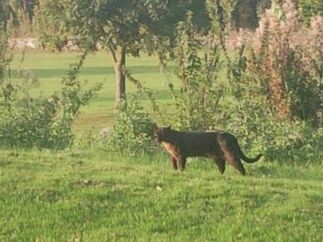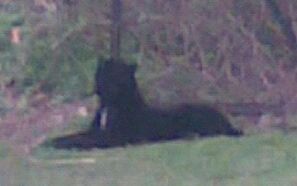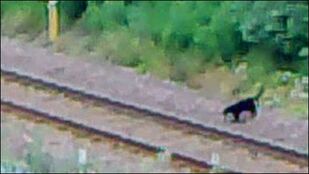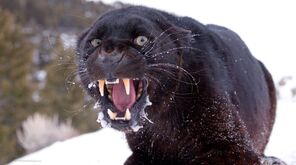
British Big Cats, also referred to as ABCs (Alien, or Anomalous, Big Cats), Phantom cats and Mystery cats, are Felidae which are not native to Britain and are reported to inhabit the British countryside. These sightings are often reported as "panthers", "pumas", or "black cats". Their existence is unproven, but many suggestions exist to explain how these animals might have come to inhabit Britain, including that they are animals released after the Dangerous Wild Animals Act 1976 came into force, or that they are surviving Ice Age fauna.
In the 1760s the great radical writer, William Cobbett recalled in his Rural Rides how, as a boy, he had seen a cat "as big as a middle-sized Spaniel dog" climb into a hollow elm tree in the grounds of the ruined Waverley Abbey near Farnham in Surrey. Later, in New Brunswick, he saw a "lucifer" (North American lynx – Felis lynx canadensis) "and it seemed to me to be just such a cat as I had seen at Waverley." Another old report was found by David Walker from The Times in 1827 of a "lynx" being seen.
Further back there is a medieval Welsh poem Pa Gwr in the Black Book of Carmarthen which mentions a Cath Palug, meaning "Palug cat" or "clawing cat", which roamed Anglesey until slain by Cei. In the Welsh Triads, it was the offspring of the monstrous sow Henwen.
A Canadian lynx shot in Devon in 1903 is now in the collection of the Bristol Museum. Analysis of its teeth suggest that prior to its death it has spent a significant amount of time in captivity.
In 1980 a puma was captured in Inverness-shire, Scotland. The capture followed several years of sightings in the area of a big cat matching the description of the one captured. However it is believed that the captured puma was in fact an abandoned pet. The puma was subsequently put into a zoo and given the name "Felicity". When it died it was stuffed and was placed in Inverness Museum.

In 1989 a jungle cat was found on the roadside in Shropshire that had been hit by a car.
In 1991 a Eurasian lynx was shot near Norwich, Norfolk. It had killed around 15 sheep within two weeks. The story was only reported in 2003, and the stuffed body of the lynx is allegedly now in the possession of a collector in Suffolk. For many years this incident was considered to have been a hoax, particularly by the hunting community, but in March 2006 a police report confirmed that the case was true. It was probably an escapee from a facility in the area that bred animals, including Eurasian lynxes.
In 1993 a leopard was shot on the Isle of Wight after feasting on chickens and ducks.
There have been reports that in 1993 yet another puma was captured in Scotland, this time in the Aviemore area.[7][10]
In 2001 another lynx was captured alive in Cricklewood, north-London. The lynx was considerably larger than an average domestic cat. The lynx was placed in London Zoo and was given the name "Lara".[11] The captured lynx was found to be only 18 months old.
In 1994 footage of a large black cat was recorded in Cambridgeshire and was named in the media as the "Fen Tiger".
In June 2006 a large black cat was recorded in the countryside of Banff, Aberdeenshire. Footage of the cat was broadcast by the BBC on 24 May 2007.
In July 2009, photographs and video footage of a large black cat were taken by an off-duty Ministry of Defence Police officer. The animal was walking along a railway line in Helensburgh, Argyll. Large cats, either black or tan, have been reported in the area before.
In late 2009 video footage of what is claimed to be a large black cat was recorded in Herefordshire. The sighting and video footage of the alleged big cat coincided with a spree of sheep killings in the same area.
In 2010 video footage of what is claimed to be a large black cat was recorded in Gloucestershire. Experts have estimated that the creature was at least five feet in length from nose to tail.
In 2000 an 11 year old boy in Monmouthshire was attacked by what he claims was a large black cat. It left him with five long claw marks across his left cheek. The police called in a big cat expert to investigate the incident.
In 2005 a man who lived in Sydenham Park in south-east London was attacked in his back garden, which backed onto a railway line. The man who was 6ft and weighed 15 stone described the cat as being a big black figure that pounced on him and was considerably stronger than he was. He was left with scratches all over his body. Police were called and according to the BBC one police officer saw a cat the size of a labrador dog.
There have been conflicting reports of DNA evidence as to the existence of big cats in Britain: In 2011 it was announced by the Centre for Fortean Zoology that DNA testing, carried out by Durham University on hairs found in north-Devon showed that a leopard was living in the area. In 2012 it was announced that DNA testing on two deer carcasses found in Gloucestershire found only fox DNA, despite many locals reporting sightings and believing that the deer had been killed by a big cat.
The research group Big Cats in Britain publishes reported sightings annually by county. The "top ten" counties or regions of Great Britain between April 2004 and July 2005 were:
| Area | Devon | Yorks | Scotland | Wales | Gloucs | Sussex | Cornwall | Kent | Somerset | Leics |
| Number of Sightings | 132 | 127 | 125 | 123 | 104 | 103 | 99 | 92 | 91 | 89 |
Species that have been noted only occasionally include the Leopard cat, which is the size of a domestic cat but has leopard-like spots, the Clouded leopard, a specialised species from the tropics which was captured after living wild in Kent in 1975, and there are even extraordinary cases of lions being reported in Devon and Somerset.

In August 2012, several sightings of a lion were reported near St. Osyth in Essex. Police searched the area using helicopters and infrared cameras, instructing residents to stay in their homes. Despite speculation that the lion had escaped from Colchester Zoo or a local circus, all such animals were accounted for. The search was called off the next day with no evidence of a lion having been found. A local resident claimed that a photo of the alleged animal showed their pet cat, a large Maine coon.
There have been reports of a cat known as The Beast of Bevendean for several years across Sussex, including in Brighton and Hove. In 2012, a local filmmaker planned to make an action-adventure film, Dark Roar, following two eleven-year-old boys who set out to trap the creature.
Current interest in Big cat reports appear to stem from the late 1950s, with news stories of the Surrey Puma and Fen Tiger. In 1963 the Shooters Hill "cheetah" was reported from that area of London and in 1964 came similar reports from Norfolk. From the 1970s reports spread across the country; the Beast of Exmoor was reported from Devon and Somerset and the Sheppey Panther has been rumored to exist since that decade. In 1980 came the first modern report from Scotland, and the Kellas Cat was shot there in 1984.
Greater interest in phantom cats grew from headline stories of the Beast of Bodmin from 1992, and Dumfries and Galloway (the Galloway Puma). A large black cat known as 'the Beast of Dartmoor' was seen by fourteen people in the summer of 2011 in the Haldon Forest. There were many more news stories from different parts of the country.
In the early months of 2011, a great number of sightings of a 'panther' in Shotts, North Lanarkshire, stirred locals and began to be reported in the local press, after a couple of months, these reports ceased with the assumption that the 'panther' had moved onto pastures new.
One of the most recent reports were of that of a lion roaming around Essex during the summer of 2012. Initially sighted from a caravan park, there were also reports of lion roaring heard in the local area. A photograph was taken by one witness. Police advised local residents to stay indoors and a search was made of the local area, but nothing was found. Local zoos and visiting circuses were contacted, but none reported an escaped lion. A Ms. Murphy later claimed the photograph was that of her pet Main Coone cat, Teddy.
In 2013, in a small village on the Shropshire-Wrexham border, two sisters reported seeing a large, black, cat-like creature with a three-foot stride jumping a fence and disappearing into a neighbouring field. On returning in the day, they discovered a large lair and paw prints too big to belong to a domesticated cat. A once time zoo-keeper at Chester zoo and Dudley zoo, Mr Larkham, agrees the paw prints do not belong to a domesticated cat but are too small to be those of a panther. He believes it could be the descendant of the Shropshire jungle cat from the 1980s, or a gigantic domesticated cat.
In 1988, the Ministry of Agriculture took the unusual step of sending in Royal Marines to carry out a massive search for the rumoured Beast of Exmoor after an increase in the number of mysteriously killed livestock, and farmer complaints over subsequent loss of money. Several Marines claimed to have seen the cat fleetingly, but nothing other than a fox was ever found. The Department for Environment, Food and Rural Affairs has published a list of predatory cats that they know to have escaped in the United Kingdom, although most of these have been recaptured.

For many hundred of years the myth of the spectral Black Dog has persisted in Britain — a supposed mythical creature appearing as a large black animal in remote moorland with no firm evidence beyond hearsay for its existence. It has been suggested that the stories of "Black Cats" are merely a modern continuation of such myths and stories, sharing the same elements but with the idea of a supernatural cause having fallen out of credibility and the modern, more plausible, idea of an escaped or released wildcat supplanting it. In addition, the stories of big cats share many traits suitable for the tabloid press — as such leading to wide exposure of any potential "cat" and further and rapid dissemination of any speculation or supposed evidence for it, helping to build a wide spread urban myth.
From a roaming "lion" in Essex to the Beast of Burnham Thorpe in Norfolk, Britain has been spotting big cats roaming the English countryside ever since the Dangerous Wild Animals Act was introduced in 1976.
Two witnesses claim they saw a lion "on the prowl" in a residential area of Bedford, six weeks after similar sightings sparked panic in Essex.
Two dog walkers claimed to have spotted the "lion" stalking a housing estate in Bedford. The women reported seeing the “orange and brown” beast prowling around the residential area.
However, while Essex police mounted a full-scale lion hunt this summer following claims of a wild animal on the loose, the Bedfordshire force took a more sceptical approach.
Essex lion, 2012
For nearly 24 hours, fear, alarm and a great deal of excitement had stalked the tiny Essex village of St Osyth amid fears there was an escaped lion on the loose.
Residents and holidaymakers had reported seeing the beast in a field and had even captured grainy footage of it on their mobile telephones.
Their claims sparked a major police operation and for a day the story of the “Essex lion” dominated social media networks and even made headlines internationally.
Finally, after scrambling helicopters throughout the night, a dozen officers to the scene, consulting animal experts and urging people to stay inside or be cautious while out and about, police said the ‘lion’ was probably just a large cat or dog, leaving the good people of St Osyth could return to their everyday lives.
Derbyshire 2007
A large black cat was spotted walking along a dry stone wall that was 3ft high. From working out how large the stones were it was estimated the cat was at least 18 inches high and 3ft long excluding the tail.
It was believed to be a young black leopard.
Experts said it was too large to be a domestic cat but could be a hybrid mix.
Hazel Grove, Manchester February 2012
Semi-retired businessman Peter Jackson told the Manchester Evening News that he had spotted the ‘mountain lion’ type creature in the back garden of his Longnor Road home.
The 54-year-old was woken by the barking of his pet dog on January 16 and spotted what he described as a ‘large black cat’.
Police later issued a warning saying that anyone seeing it should not approach the animal. Jean Bruckshaw, 80, of Grendale Avenue, contacted the paper to say she had seen the cat the day before Mr Jackson.
She said: “At the time I was washing the dishes and looked out of the back window and saw a large black cat prowling in a neighbour’s garden.“
"It had a big tail similar to a fox but not a brushy one, and I can say I have never seen such a huge cat before.
“My neighbour also said that she had seen it.”
Mrs Bruckshaw said she thought the cat made its escape onto a railway embankment behind her street.
Beast of Burnham Thorpe, Norfolk, 2009
The wildcat dubbed the Beast of Burnham Thorpe in Norfolk was spotted near the Queen’s Sandringham home.
Experts claim it was a Scottish wildcat, which has been known to attack humans with their razor-sharp claws, or a lynx.
Others claimed it looked more like a domestic tabby.
Buckinghamshire panther, 2009
A photograph showing a panther-like cat sitting near woodland is the best evidence yet that large animals are roaming the countryside, experts claim.
Electrician Paul Keehn, 35, claims he snapped the creature on his mobile phone after spotting it sitting by a fence near residential homes which backed onto woods and fields.
Mr Keehn took the photograph and then ran inside flats where he was working to tell the landlord but by the time the pair came back the panther-sized animal had disappeared.
Beast of Banff 2007
A big black panther-like animal was spotted only yards from the edge of Banff.
It was seen on the prowl in broad daylight above the Links, terrifying a holiday visitor who was out for an afternoon stroll.
At least one nearby resident also claimed to have seen the big cat at close hand.
The creature is described as being five feet long and three feet high. It walked across the path of a man who was staying at the Banff Springs Hotel over the holiday period as he was out for a walk near the hotel on Hogmanay according to the Banffshire Journal.
Helensburgh, Argyle 2009
An off-duty Ministry of Defence police dog-handler took a video after spotting a panther-sized big cat.
Pc Chris Swallow told the BBC he was helping a friend with their garden in Helensburgh, Argyll, when he spotted the black creature on a nearby railway line.
The officer, who was stationed at the Faslane naval base on the Clyde, said the cat was as big as a Labrador dog.
Big cats had been reported in the area in the past, with several sightings of the so-called Coulport Cougar.
"I've heard stories about creatures like this moving about the countryside, but never really believed them before," he said.
Newtown Crossroads, Herefordshire 2009
A large black cat was filmed prowling across fields in rural Herefordshire in December 2009.
Steve Hall contacted the Hereford Times when he managed to to capture video footage of a large black cat resembling a panther crossing farmland near Newtown Crossroads.
Mr Hall was out walking his dog when they spotted the creature.
“It was just walking across the hedge and then it saw us and sat in the hedge a bit watching.” Mr Hall said.
“I thought I saw one a few years ago but I wasn’t too sure as it was dark, but this footage proves they are local. It was far too big to be a domestic cat.”
There have been numerous sightings of big cats stalking the Herefordshire countryside.
“I go out all the time in the countryside and know the difference between a cat and a dog,” Mr Hall told the paper.
“This was definitely a big cat.”